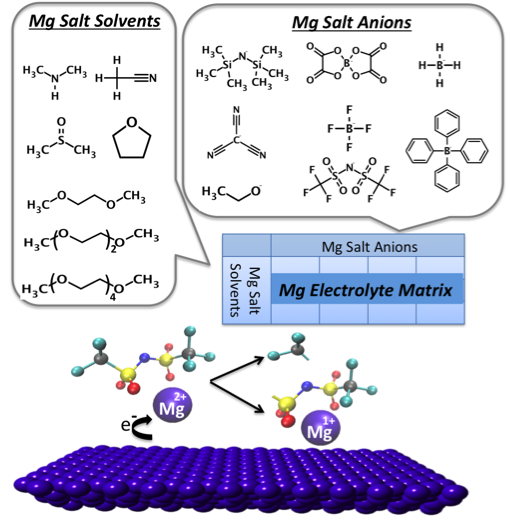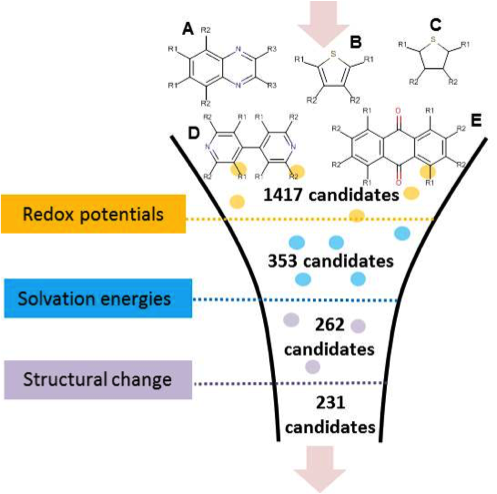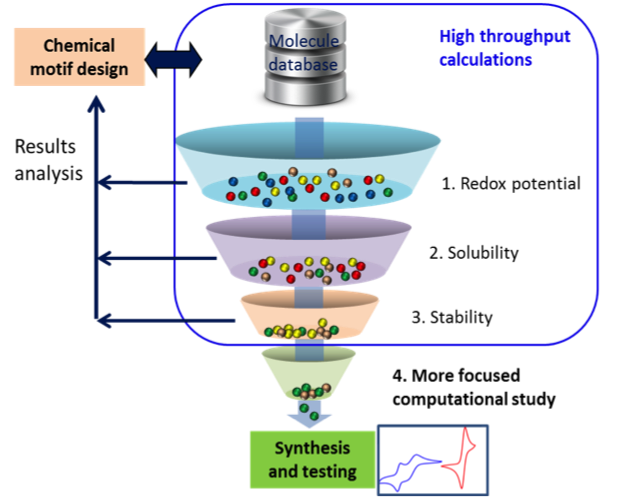Electrolyte Genome
-
The Electrolyte Genome Project
Traditional chemistry relies on intuition and experience to select a few materials that might work well for new electrolytes. The Electrolyte Genome streamlines this process by evaluating thousands of materials by simulation on the computer and choosing the most promising few for synthesis in the laboratory. Read More
-

Redox Mediators that Promote Three-Dimensional Growth of Li2S on Carbon Current Collectors in Lithium-Sulfur Batteries
Developed, from computation and experiment, redox mediators that allow 3-D growth of Li2S on carbon current collectors for greater capacity utilization in Li-S batteries Read More
-

SC15 High Performance Computing (HPC) Transforms Batteries
A new breakthrough battery—one that has significantly higher energy, lasts longer, and is cheaper and safer—will likely be impossible without a new material discovery. Kristin Persson and other JCESR scientists at Lawrence Berkeley National Laboratory are taking some of the guesswork out of the discovery process with the Electrolyte Genome Project. Read More
-

Electrolyte Genome Reveals New Instability Mechanism in Mg Electrolytes
imulations of a matrix of Mg salt and solvent combinations revealed a strong tendency to ion pair formation. Close association of the salt anion and cation within the first solvation shell, even at modest concentrations. Read More
-

Accelerating Electrolyte Discovery for Energy Storage with High Throughput Screening
We have developed a strategy to down-select a pool of candidates based on successive property evaluations and to eliminate unpromising candidates at an early stage. Read More
-

Realizing the Electrolyte Genome
JCESR is building a highly sophisticated infrastructure for high-throughput evaluation of molecular properties. This involves coupling ab initio DFT methods with rapid classic molecular dynamics, calculations of redox potentials, and solvation structure while more detailed reactivity studies are carried out. Candidates that meet performance metrics for different types of battery applications (redox-flow, Li-air, Li-sulfur and multivalent) are prioritized for synthesis and testing. Read More
-
EDL: Discovering Electrochemistry at Atomic and Molecular Levels
Established in situ Electrochemical Discovery Lab (EDL) for systematic studies of wet and dry interfaces for materials-by-design and electrolytes-by-design at atomic and molecular levels Read More
Latest Updates
-
You’re Invited - JCESR and Beyond: Translating the Basic Science of Batteries
Please join us at Argonne National Laboratory on Tuesday, April 4, 2023 for JCESR and Beyond: Translating the Basic Science of Batteries. Registration is now open. This in-person event will celebrate 10 years of research from the Joint Center… Read More
-
A Message from JCESR: In Memory of George Crabtree
It is with heavy hearts that we say goodbye to George Crabtree, a Senior Scientist and Distinguished Fellow at Argonne National Laboratory, and Director of the Joint Center for Energy Storage Research (JCESR), who passed away unexpectedly on January 23. Dr. Read More
-
Cyanopyridines As Extremely Low-Reduction-Potential Anolytes for Nonaqueous Redox Flow Batteries
Discovery of a cyanophenylpyridine derivative with a very low reduction potential and good stability during cycling. Read More
-
Characterizing Redoxmer – Electrode Kinetics Using a SECM-Based Spot Analysis Method
Identified asymmetries in electron transfer (ET) kinetics between the reduction and oxidation of ferrocene-based redoxmers by measuring the ET rate constants (kf/kb) as a function of electrode potential. Read More
-
Benzotriazoles as Low Potential Anolytes for Non-Aqueous Redox Flow Batteries
We developed an easy-to-synthesize benzotriazole-based anolyte with a high energy redox potential (-2.3 V vs Fc/Fc+) and high solubility that demonstrates stable electrochemical cycling performance. Read More

